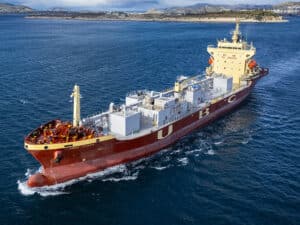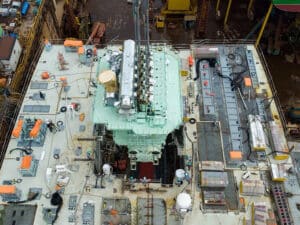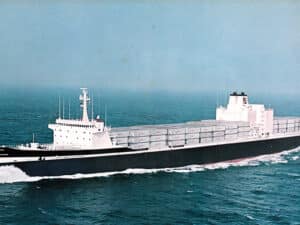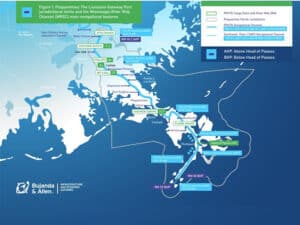
Fair (offshore) winds for the Jones Act finance market
Written by Marine Log Staff
Credit: Shutterstock
By Basil M. Karatzas, Founder, Karatzas Marine Advisors & Company

Until recently, the offshore drilling market had the distinction of employing the most expensive assets in the maritime industry. A decade ago, eighth generation drillships cost almost a billion dollars each to build. The winds of change, however, have been taking—metaphorically—the wind off offshore drilling and in favor of the offshore wind market.
Harvesting wind is an old art, and modern land-based energy-producing wind turbines have been a common sight both in the US and overseas for almost a decade now. Harvesting wind offshore is technologically more challenging, but the rewards can be monumental. North European countries typically seem the most determined to put the forces of nature to good use, and Scotland alone has 894 MW of installed offshore wind capacity already.
The Block Island Wind Farm in Rhode Island, with 30 MW of capacity, was until recently the only offshore wind project in the U.S. The project has been relatively close to shore and its five wind turbines were mostly a demonstration that offshore wind is a feasible prospect rather than a meaningful source of energy. However, rapid changes in the energy (and political markets) have seen that already six states expect to be able to source almost 9,100 MW from offshore wind by 2026, and broader goal of 30,000 MW by 2030. And, clearly, over the longer term the sky is literally the limit in terms of capacity to be installed and harvested.
The numbers are jaw dropping and they deservedly have drawn the attention of executives from numerous market sectors and industries associated with marine, from shipbuilders to port operators to bankers. To meet such targets, several thousands of offshore wind turbines will have to be installed (and maintained over time), and several hundred of offshore wind vessels ranging from research vessels to Crew Transfer Vessels (CTV) and Service Operation Vessels (SOV) to the most critical Wind Turbine Installation Vessel (WTIV) will have to be built and deployed. Understandably, the excitement has not been this high in the Jones Act market since the price of oil topped $150 per barrel some time ago!
However, building infrastructure costs money, especially building infrastructure in the open sea that will be pummeled by the elements of nature day and night for decades to come. And, it’s not just the wind turbines that get more expensive as they get bigger and more efficient; the fleet of vessels that will install and serve this market will cost several billions of dollars to be built in the U.S. Getting the financing for such expensive assets will be tricky, at least, in the beginning.
Unlike the offshore drilling market that has matured over time, offshore wind is still a nascent industry, especially in the U.S., and there are teething pains to deal with before any wind farms can be up and running. When a bank provides a shipping loan, typically it depends on decades of data that will provide it with a fair assessment of the vessel’s residual value over time, the collateral in the event of default.
For now, there are effectively zero offshore wind vessels on U.S. waters, and accordingly precious few data-points on how these types of assets will “age” over time. To further complicate future value estimates, the specification and characteristics of the proposed offshore wind vessels can evolve quickly as the first generation starts getting employed, and practical feedback is collected from the field to be incorporated in subsequent generations.
There is substantial risk for technological obsolescence, from an appraiser’s point of view, that can make the first generations of assets to depreciate much faster than expected. And, although there are foreign-flagged offshore wind vessels that have been operating for almost a decade now, it’s well known that foreign and Jones Act assets do not depreciate analogously over time.
We expect the shipping finance market to evolve over time and eventually become a full-blown market on its own right, the same way the financing for offshore drilling has matured over time. Equipment financiers and lessors and small and middle-market U.S. banks will very soon get active in the market and start offering customizable financial packages, just as they do now for inland, coastal, and the offshore marine market.
For now, at least, the financing has started more conservatively and is much more dependent on the creditworthiness of the parties involved rather than the assets as collateral. It’s only normal to start with the basics, and soon enough the competition will bring more flexibility once the market gains traction.
The first Jones Act WTIV has already been ordered at a contract price approaching $600 million—just for one vessel alone! The financing of the vessel has already been in place by a syndicate of US banks, and at very competitive terms (reportedly well below 5%). And, although its financing has been arranged as a lease, the syndicate members only underwrote credit risk, with much of the operational and residual asset risk remaining with the developer.
Financing for “green” projects is a hot topic for now. We tend to believe that offshore wind is just another form of financing in the energy markets, and everything boils down to risk and returns. It will take a couple of years for the market to establish itself, but soon enough offshore wind financing will be as easily accessible, as in other segments of the Jones Act market.




